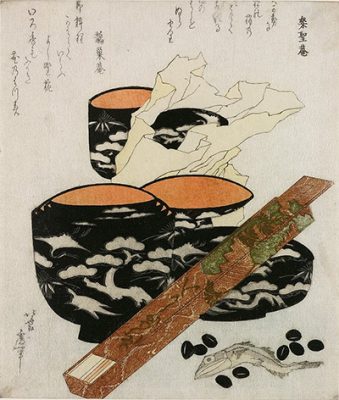Hokusai
Still Life by Hokusai
Katsushika Hokusai (1760-1849) was one of the most famous Japanese artists of the nineteenth century. His most well-known work, made in his seventies, was The Great Wave, one of a series of coloured etchings the artist made of Mount Fuji. Earlier in his career he made a large number of woodcut prints including several Still Lifes.
The one described here is known as the Double Cherry Blossom Still Life which, like his other Still Lifes, has several apparently unrelated objects, in this case a telescope, some sweet fish, a tissue case, cherry blossom and two poems. Hokusai was trained in Shunsho’s studio as a ukiyo-e (floating world images) painter and printmaker. He differed from other artists in this genre preferring landscapes to portraits. He was much influenced by the work of Sesshu Toyo, a great exponent of the ink and wash technique producing abstract-like paintings such as ‘Splashed Ink Landscape’. Hokusai was also influenced by Dutch and French copper engravings he had acquired that made use of Western perspective which he later introduced to Japanese art.
The Shinto religion is another influence that manifests itself in the suggestive nature of his Still Lifes. 30,000 drawings were left at the artist’s death along with illustrations for 500 books and several treatises on drawing techniques including 15 volumes of the Manga containing his most famous works. His legacy lies in Impressionism, a movement resulting, in part, from Monet and Renoir being captivated by Hokusai’s work. The Double Cherry Blossom Still Life, c.1804 to 1813, is kept in the New York Metropolitan Museum of Art. It is a polychrome woodblock print measuring 20.6 by 27.1 cm and, in 1929, was bequeathed to the museum by Mrs. O.H. Havemeyer.
The two poems in the upper part of the print describing cherry blossom were written by the poets Asakusa-an and Teika-an. Beneath the poems are a strange juxtaposition of objects including sweet fish, a tissue case, a telescope and a branch of double cherry blossom. This mixture of things from both the natural and the man-made world is probably not meant to be explained but the telescope may suggest an alternative Western way of seeing the Japanese world.
